#Kitsuke
Explore tagged Tumblr posts
Text
THE KITSUKE GIRLS of OLD JAPAN
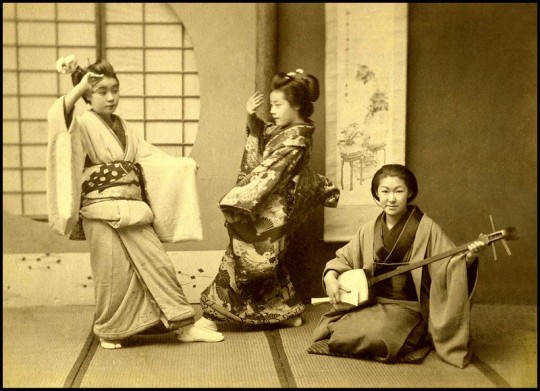
★ KITSUKE 着付け --- The manner of dressing, especially the proper wearing of a kimono. It is also used to mean "dressing neatly and nicely". To some degree, your kitsuke also involves the artistic sensibilities you exercise when matching up a given Kimono with a given Obi. And etc etc.
★ OHASHORI おはしょり --- The folded excess of Kimono fabric that "hangs" under the OBI (waist band) after raising the bottom of the kimono to properly graze the floor.
Circa 1890-95 large albumen print. Negative No. 268 by an unknown photographer.
21 notes
·
View notes
Text

Edo period women obi knots, fantastic reference chart by Edo lover Nadeshico Rin.
You can see here several obi musubi favored by city women, of all class and status. Novelty knots were a fashion statement, often lauched by star onnagata kabuki actors, and spread by iki fashionistas such as geisha.
For top to bottom, left to right, you can see here:
Chidori musubi (plover knot) ちどり結び
Shôryû musubi (little dragon knot) 小龍結び
Kichiya musubi (Kichiya knot) 吉弥 結び - named after onnagata actor Uemura Kichiya I in Genroku period, who single handedly launched a new type of knots and obi fashion
Koman musubi (Koman knot) 小万結び - named after a kabuki character in play Yakko no Koman
Nagoya obi (Nagoya belt) 名古屋帯 - Azuchi Momoyama/Early Edo era silk kumihimo tied in butterfly knot
Yanoji musubi (arrow knot) 矢の字結び - created by onnagata actor Segawa Kikunojo II. Also found under the name tateya musubi 立て矢結び (standing arrow knot)
Yoshio musubi (Yoshio knot) よしお結び
Mizuki musubi (Mizuki knot) 水木結び - onnagata actor Mizuki Tatsunosuke is said to have first worn this variation of the Kichiya musubi
Rokô musubi (rôkô knot) 路孝結び - created by onnagata actor Segawa Kikunojo II
Karuta musubi (card knot) カルタ結び - created in early Edo period, looking like 3 playing cards side by side
Hitotsu musubi (single knot) 一つ結び - during Edo, was also called darari musubi だらり結び. Note that it differs from is nowadays called darari obi (worn by maiko)
Tate musubi (standing knot) 立て結び - see yanoji/tateya musubi for variations
Bunko kuzushi (unbalanced knot) 文庫くずし
Heijûrô musubi (Heijûrô knot) 平十郎結び - created by actor Murayama Heijûrô III
Sageshita musubi (falling knot) さげ下結び
(by request of @fireflybettle, hope this will help you ^^)
#japan#fashion#fashion history#references#ressources#nadeshico rin#edo period#edo era#obi#musubi#obi knot#kitsuke#chidori musubi#Shôryû musubi#Kichiya musubi#Koman musubi#historical Nagoya obi#Yanoji musubi#tateya musubi#Yoshio musubi#Mizuki musubi#Rokô musubi#Karuta musubi#Hitotsu musubi#Tate musubi#Bunko kuzushi#Heijûrô musubi#Sageshita musubi#darari obi
2K notes
·
View notes
Text

Oh, I completely forgot to post this during the con! I met the "cast" of Thunderbolt Fantasy up close (and shamelessly ogled/photographed the puppets' costumes, because that series has been on my to-cosplay list for the better part of a decade).
Also featuring my Friday kitsuke, which I guess I have a picture of after all (albeit in truly terrible lighting). This gorgeous metallic furisode was the first kimono I ever bought, kicking off yet another expensive new hobby that I probably didn't need. 😅
48 notes
·
View notes
Text




i have finally started listing my collection of antique haori and kimono. im using ebay's built-in charity system to send 20% of the sale to the Palestinian American Medical Association, who has a 96% rating on Charity Navigator. i've started the listing price high on this one, because it appears to be nearly flawless, and also because it will drop gradually over time using an ebay listing tool that slowly reduces listing prices, so it should be able to find its correct market that way. so feel free to throw it in your watchlist and check it later
45 notes
·
View notes
Text






So, she's horrified, and I absolutely get it. I would also be horrified. But, you didn't know! This is the most understandable kind of mistake. You were never told. How were you supposed to know?
Neither GInko nor Kitsuke hold it against you. I wouldn't either! It was a terrible mistake, but it was not done with any level of malice at all, and despite what the internet might say, intent does matter.
PLease please do not spoil anything for me in your excitement. I don’t want to know anything! I don’t even want to know if something is a cultural difference, or if you can’t wait for me to get to a part. If I wonder about something, please don’t say stuff like “Just wait til…” You know what is great for all that? The discord! Which apparently has its own mushishi channel now, which must mean y’all are excited for it!
7 notes
·
View notes
Text
A loot from kimono heaven
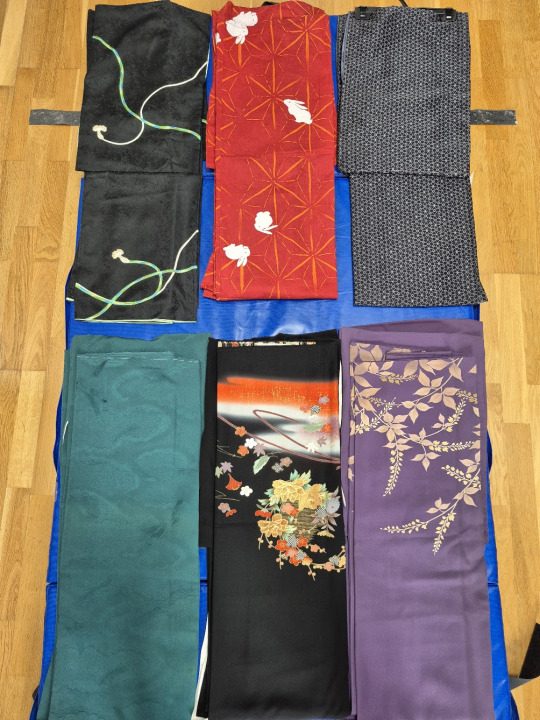
We've been to countless kimono-stores during our latest Japan trip, and returned with 6 kimonos.
I had some colours in my mind I desperately wanted, however, I haven't too big of a variety to choose from, considering my unusual, not-at-all-Japanese body type. This means that even if I found a larger size, there is a great chance the sleeves would still be too short.
Semba Center in Osaka, despite of its vastness and infinite neon lights, had a surprisingly good selection of kimono shops, and since the customers are about 98% locals, the shop assistants are knowledgeable and helpful.
I really wanted to have either a vibrant, royal purple or a subdued greyish purple iromuji as my second piece, but they were all too short, the deep petrol green jacquard, however, was perfect, and it really is my colour, so I bought it without hesitation.
My husband wanted to gift me a very beautiful one for my birthday, and encouraged me to look further for a formal piece. We found a slightly greyish shade of purple houmongi with gold pattern and we bought that too.
Chicago in Kyoto can be good for casual hunting. If you are looking for something to actually wear, like, properly wear, the only sizing guide you can go by is S-M-L, and the styles are separated. Otherwise the shop assistants don't put too much effort in properly packaging them for you. As I didn't have a yukata yet, I wanted to buy a cheap one so I have at least one for occasional summer jobs to wear. As the sizings are not so elaborate here, I mostly rummaged through large sizes until I found something that didn't look like a bedsheet. I am not a huge fan of yukata designs, but I found this cute red one one with the bunnies (top middle). Sleeves are too short, obvi, but it's for summer, so I may get away with it.
The black tsukesage at the top left was too cheap (about 5000 yen) to leave there. I have never seen a black tsukesage before, and I wanted it immediately despite probably never being able to wear it due to its shorter sleeves. This will likely be my practice-piece at home.
I was also influenced to visit a larger recycled kimono shop in Kyoto which mostly specialised in yukata and furisode. Well, I already had the former and I can't have the latter (because I'm married), but I asked the very, very old shop assistant lady if they have komon, and they had a few in the back. To my absolute delight, those were washable, polyester ones which are perfect for our not-so-pristine work environment, e.g. pouring sake all over the place. So I purchased the black one with the geometric asanoha pattern (top right).
At this point I considered the mission to be completed, although I still haven't owned a few styles yet. I haven't found any iro tomesode and a kuro tomesode. Chicago was full of the latter, but not the right size, even some stains in too visible places. I decided those would be for another time.
While roaming the shopping arcades of Kyoto on our last day though, I stumbled upon the shop where I bought my favourite obi two years ago and it was calling to me. I quickly went through the recycled selection with the shop assistant lady as they were all gorgeous. Nothing fit me though except the one thing I didn't expect to: the kuro tomesode. Well, normally I would have let it go, as it is such a high formality kimono that I could easily overdress the Japanese Ambassador herself in it, but if was exactly my size for only 5000 yen, a one of a lifetime bargain, with no visible stains or faults.
So that's how I ended up buying 6 kimono despite wanting only 2.
And I haven't even got into the accessories yet, but that's for another post.
8 notes
·
View notes
Text

tumblr ate my post before, but I got an incredible deal on a new (vintage) furisode, 3 obis, and a number of obijime on fb marketplace. I put together an outfit using a fukuro obi I had… now I just need to come up with an excuse to wear it!
11 notes
·
View notes
Text
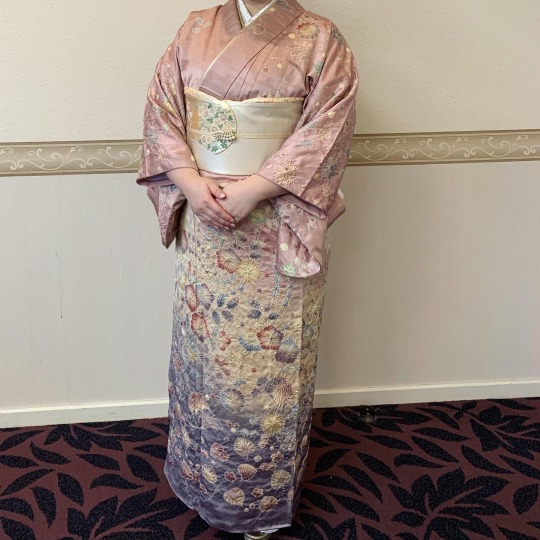

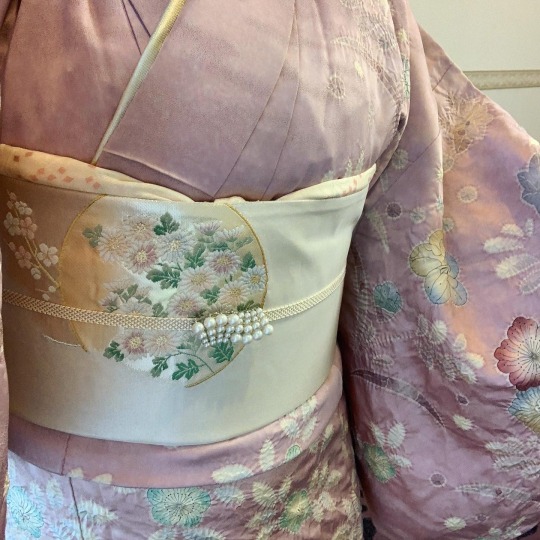
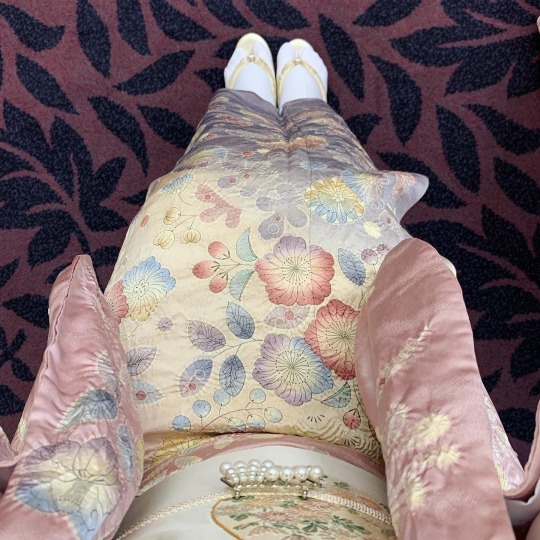
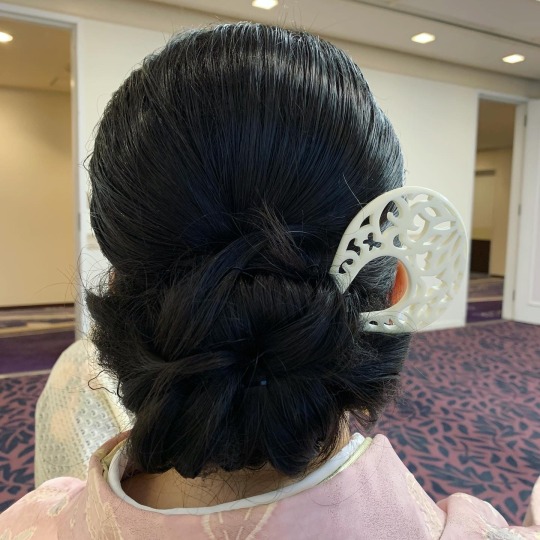

Fulfilled a lifelong dream of being professionally dressed in formal kimono in Japan for an event!
I learned loads of kitsuke tips - definitely worth paying money for them to sew on the haneri and preparing the kasane’eri to see how the professionals do it!
Also very happy with how the coordinate turned out - everything came together really well! Worth the months of finding different pieces to go together - but actually quite a few of the main pieces (obi, obiage, kasane eri) were from my existing collection.
Congratulations on the successful completion of the event!!
71 notes
·
View notes
Text
A kimono dealer in Japan mentioned that he might, potentially, possibly maybe, get a small spot on a news show about his shop.
"Estate Sale" style lots of assorted items to bid on is not common in Japan like it is here. So odd lots of old kimono are very cheap, often $100 USD or less for half a dozen items. But they aren't necessarily items that would be worn together, if someone has a sense of formality, colours, types of kimono, etc. They're great for mixing with yofuku or maybe photoshoots as-is, but if using as intended...
Look y'all. The autistic gaijin kimono collector most certainly didn't take this as a sign to make review photos as perfect as possible. Right?




The first set:
The kimono + fan came from Kazuma. The other items are from my collection.
The single-layer synthetic kimono reads as an odori piece, so it's paired with a gold odori obi and bold red accessories. The collar and obiage match in fabric type (ro) but I don't have a red summer obijime (the cord on the obi belt.) I thought one might not have the right effect if this were on stage anyways. The fan is also for dance performances.
I think now, I should have done bunka musubi, but I went with a long hanging obi inspired by geisha in Tokyo area.



For this, I chose entirely summer items, ro whenever possible to match the juban. This only features the summer obijime from the lot.
The nearly-black colour with pampass grass is a symbol of deep summer and a hope for coming coolness. Dark eggplant purple and brilliant gold is another summer choice, linking with January references to eggplant and a desire for cool weather. The obi is tied in a big, airy otaiko in an asymmetric knot, a reference to days of kitsuke long gone by.
The brilliant red obiage is a classic pairing, and the nearly-white blue obijime is the colour of snow. They stand out against the colour of the obi very well. The obijime very nearly matches the grass pattern.
The fan tucked into the obi is made of light-coloured wood (dark wood is for autumn and winter) and has a simple pattern of swirling green maple leaves, tinged in gold. Momiji (maple) will not become gold until later in Autumn. Right now, green and black are vibrant, and the gold in the fan pairs with the gold in the obi. Hints of a breeze also evoke a cool feeling.



For the last set, the fukuro obi and michiyuki is from Kazuma.
I picked a bold floral hitoe kimono with komono (accessories, lit. "small things") that were bright and cheerful. The collar and obijime match here, pulling from the purple details in the flowers. The obi also has elements of orange and gold, akin to the orange and yellow in the flowers. The white silk obiage has cute triangles of bright colours, in pinks, yellow, orange, and turquoise.
I wanted to make something a fun 20-something would wear out with friends.
Since the kimono is so youthful, as are the coordinating pieces, I wanted to do something ... not boring.
A musubi that is not ginza/tsunodashi, otaiko, or ribon (ribbon). Something cute! Fluffy looking! Effeminate! Something that in passing, is layered and has curves like the tiny flowers in the kimono. Maybe I was successful.
The obiage too, I wanted to be youthful but not childish or too "formal" like a furisode. Especially since the "creative" musubi (knot in the back of the obi) are too often reserved only for the long-sleeved formal kimono. Hnnn. I wrapped it in a way to show off the colourful patterns and tucked in one side to make a cute ruffle, again to mimic the obi and kimono pattern.
A plain obijime then, would be boring by contrast... so maybe don't make it TOO showy, like it's a furisode, but a little bit wavy and fanciful.
How did I do?
6 notes
·
View notes
Text
I suspect this particular seller in Japan is a textile mill, where piles and piles, HUNDREDS of unwanted kimono, are sold at-cost prices. Artificially low, even. I honestly don't know how they are paying their employees.

Despite all the financial things, spending $20 at a time seems to give me a reason to keep doing things. When I saw this pattern, I was transported back to the Chinoiserie of my great-aunt's 1970s and 80s USA decor.
All of these items, save the shoes (I think) come from Sou. I made most of the komono, like koshi himo, which tie the kimono shut.

The juban is not quite the right size for the kosode, but that can be fixed. Or I just need a few more (that one, actually.) But it is ro, properly worn July-August, when Japan was once hottest. In Florida... that could be any day but December.
The kimono is hitoe (unlined) for summer but is not usumono, transparent. I am embracing these wool and wool-blend kimono without transparency. It takes pressure off me to have immaculate layering. This kimono has some cream, matcha-iro patterns, bamboo, ohagi, kiku, botan... a ... four season kimono? Three season is typical, but maybe ohagi and the grasses can make it 4 seasons.
There are some stains. I haven't tried to get them out. Since the kimono was sold this way, I suspect they may be permanent. The pattern is so busy they won't be noticeable very easily.

The obi is a synthetic, somewhat stiff piece. Technically a nagoya obi, it is open and untailoured. I like it as-is. One half is bold black/salmon stripes which reminds me of the 20s and 30s style. The other is a more traditional hakata look. The tare folds in half while the taiko is one side or another. It IS a bit stiff and slippery, being synthetic, so tying it was difficult. It doesn't help that the mannequin spins and doesn't have a lock.
The haneri and obiage are also ro for "deep summer." There is a nice tradition of wearing accessories slightly ahead of the seasons to signal looking forward to it. The haneri is synthetic, I think, but the obiage is silk with nadeshiko and pampass grass patterns (August.) Obijime is a very open weave in a creamy white that nearly matches the obiage. The weave pattern is meant to mimic the hakata weave of the obi.
The fan is in the pale wood for summer. The pattern on this one is wind and water, leaves floating on the breeze to indicate coolness. The colours are not yet Autumn.
Shoes also indicate the heat with straw woven soles. The black and grey striped hanao look great with this outfit.
Wrist to Wrist: 49.5" Sleeve Length: 18.3" Neck to Hem: 61" Body Width: "* *all reported by seller. Not taken independently.
8 notes
·
View notes
Text
Some snaps from yesterday's year end party.
My kitsuke skills have improved greatly since I started in 2020!

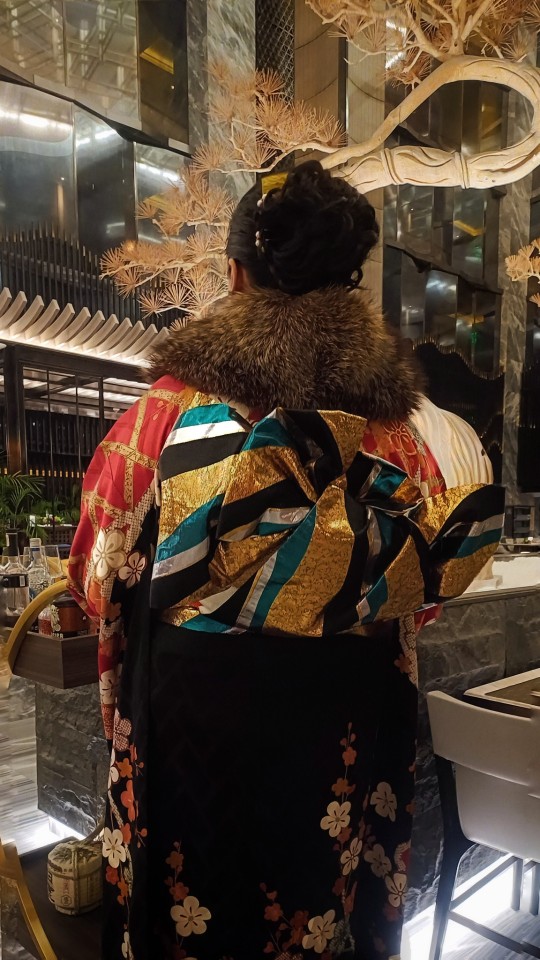
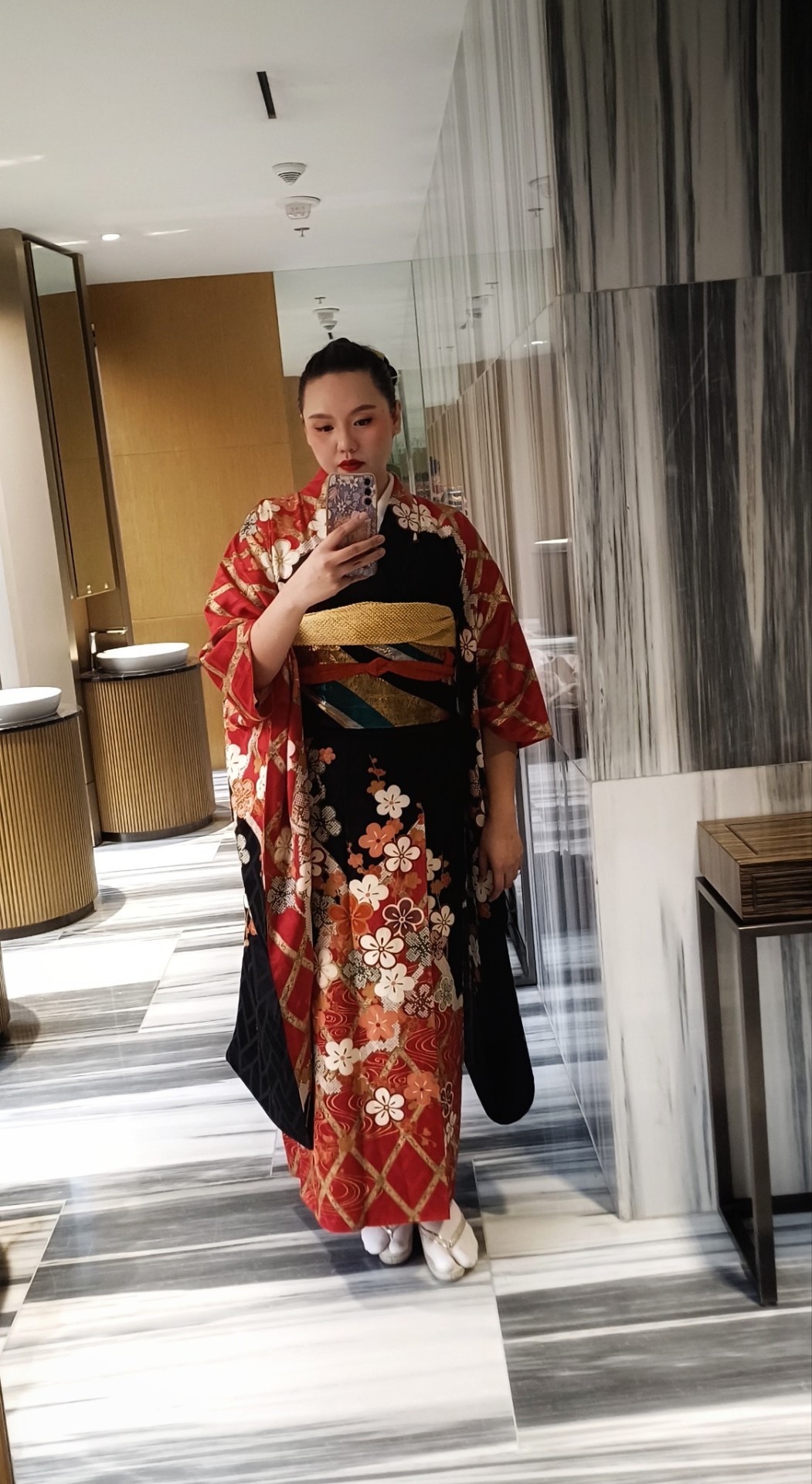



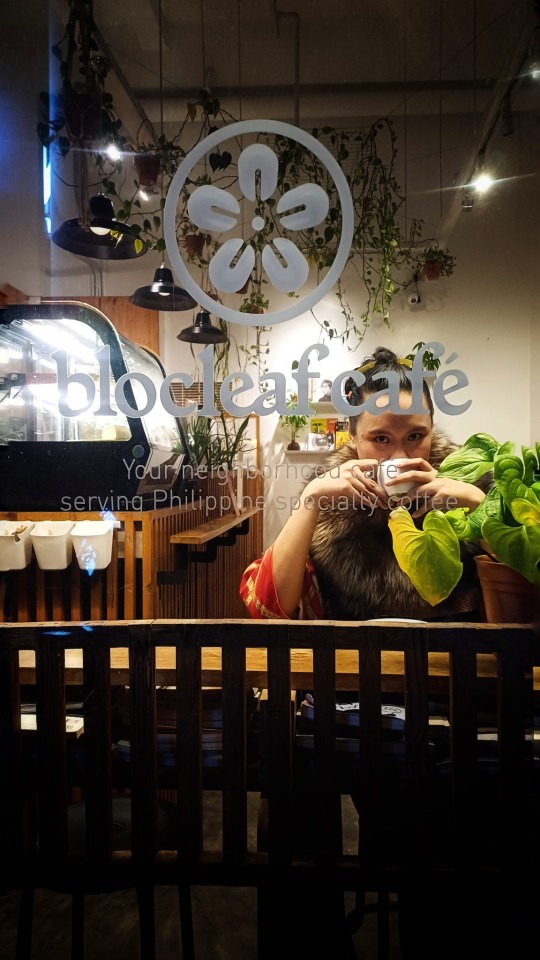
5 notes
·
View notes
Text
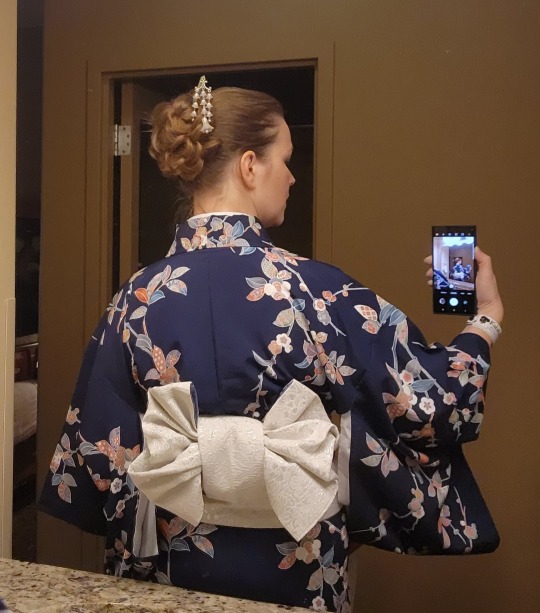
First attempt at tying リボンむすび (ribbon musubi). It's not perfect, but not a total disaster! I used Billy Matsunaga's YouTube tutorial.
Considering that two days ago I had only the kimono and nagajuban, and I made the obi, obiage, and all the assorted ties and accessories in a mad overnight scramble, I think it came out pretty well! 😅
44 notes
·
View notes
Text
need to get some platform house shoes so my dang kimono aren't tripping me up. and YES I know about folding it up under the obi i do not have time for that bull crap every day. also my actual dress zori which were supposed to be my house shoes got worn to one (1) wedding and the soles came off and I cannot be fucked to fix them yet
43 notes
·
View notes
Text
Okay not going to lie you guys I’ve been spending time on Reddit lately and I made a post that was like “hey I know it’s less than ideal but I plan to store many kimono in vacuum bags and/or plastic bins, they’ve been living in suitcases for years and I really can’t stand it anymore, does anyone had advice for avoiding ‘storage smells’?” and the comments are all like YOU NEED TO WRAP THEM IN ACID FREE PAPER and YOU NEED TATOUSI and GET A CEDAR OR PAULOWNIA CHEST FROM AN ESTATE SALE and it’s like MOTHERFUCKERS I am a professional I know this is not the best way to store them but I’m currently unemployed and only have storage in my bedroom I fucking WISH I had $100-800 to spend on this project but I don’t!!!
5 notes
·
View notes
Text
Classy and Creepy
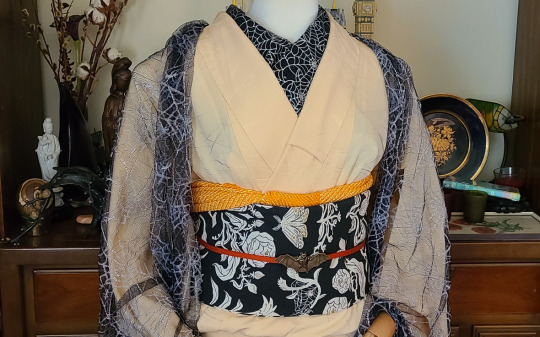
Happy Halloween! An appropriate day to raise myself from the dead, I think. I've just been incredibly busy, travelling and working and whatnot, but I do have some stuff in the works for the next little while. I knew I had to get this one up today, though. The "obi" is too perfect for a classy and creepy outfit. Funny thing is, it's not an obi at all. It's two table runners from Target! One wrapped twice around the body, and one for the musubi. I wanted to keep the rest of the outfit subtle but still halloween-y so my bat menuki obidome and spiderweb haneri, and then remembered I had this lovely piece of soft spiderweb mesh I found in a remnant bin at the fabric store. It makes the perfect shawl, doesn't it? I love how this outfit feels seasonal and creepy but totally wearable, and I also love how the two star pieces are both found items that have nothing to do with kimono. The orange accessories were the finishing touch, and they add just the right amount of pop. Read the full article
19 notes
·
View notes
Text
One day left till Japan,
and I was still watching kitsuke videos at midnight.
I found some obi makura types that could be a game changer for me in terms of time management and overall tidiness of the obi.

This is not a fancy car seat for babies, that's a kairyou makura! And it could help me pre-tie the back of my obi on the floor, which is either a blessing or would confuse me even further and would end up with me desperately changing back to the ways I've known already for years... but I'm open.
2 notes
·
View notes